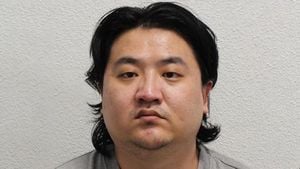In a whirlwind week that has seen federal authority sweep through America’s largest cities, the nation finds itself grappling with the consequences of sweeping executive decisions, contentious protests, and symbolic gestures that harken back to earlier eras. From the streets of Los Angeles and Washington, D.C., to the skies above Tuskegee, Alabama, and the halls of Congress, the events of September 2025 have left an indelible mark on the country’s social and political landscape.
Los Angeles, a city known for its resilience, is still reeling from the aftershocks of a rare and controversial federal deployment. In the spring of 2025, federal immigration enforcement in the region surged dramatically, with arrests quadrupling between April and June. According to official records, the share of immigrants arrested without criminal convictions jumped from 35% to a staggering 69% in just two months, challenging the Trump administration’s public stance that enforcement focused on criminals. Reports of racial profiling by federal immigration officers, as documented by Los Angeles Times, led to a short-lived court order barring stops based on race, language, job, or location—an order later overturned by the U.S. Supreme Court.
By early June, protests erupted throughout Los Angeles in response to escalating immigration raids, concerns over inhumane detention conditions, and mounting evidence of racial profiling. Local officials, aiming to de-escalate tensions, imposed overnight curfews in downtown LA. But President Trump, over the objections of California’s governor and city leaders, dispatched 4,100 National Guard troops and 700 Marines to LA, citing the need to protect federal personnel and property from protestors. It was the first such deployment without a governor’s consent since the 1960s—a move Governor Gavin Newsom quickly challenged in court, calling it a violation of federal law and an unlawful bypass of state authority.
By August, most troops had been withdrawn, leaving just 250 National Guard members in the city. The Trump administration claimed victory, boasting of restored public safety. But the numbers tell a more complicated story: the Department of Justice charged only 26 individuals with protest-related crimes, dismissing eight cases soon after, five of them due to false statements by immigration officials. As Washington Post highlighted, the deployment’s disruption extended far beyond the legal system. Small businesses suffered steep drops in sales and foot traffic, student attendance plummeted, and healthcare visits by immigrant patients declined sharply. The city’s vibrant pulse faded, replaced by apprehension and uncertainty.
Military leaders themselves expressed unease about the mission. Court documents revealed their doubts about troop preparedness for domestic operations and worries that the deployment might provoke further unrest. National Guard members, many left with little to do, voiced concerns about morale and recruitment for years to come.
The cost of this operation has been staggering. The Department of Defense initially pegged expenses at $134 million, while Governor Newsom’s office estimated $120 million had already been spent by early September. Yet, as California’s senators and governor pressed for more detailed accounting, the true financial toll remains unclear—especially when factoring in the broader economic and social fallout for LA’s communities.
Even as the legal battle over the deployment continues, with the Trump administration appealing a federal judge’s finding that the use of National Guard troops for civilian law enforcement was illegal, the city is working to recover. Local officials have launched funds to help communities rebuild and introduced new measures to protect immigrant families in schools. But the scars left by the summer’s turmoil are not easily healed. Mixed-status families, undocumented residents, and U.S. citizens alike have had their lives upended, and other major cities now watch warily, bracing for the possibility of similar interventions.
Meanwhile, in the nation’s capital, the federal presence has also been felt acutely. On August 11, President Trump initiated a 30-day federal takeover of the Metropolitan Police Department, deploying federal agents and hundreds of National Guard troops to Washington, D.C., under a self-declared “crime emergency.” This, despite the fact that crime rates were at their lowest in decades. The move sparked massive protests, with thousands marching under banners reading “End the D.C. Occupation.” As reported by Politico, the demonstration on September 6 was one of the largest yet, highlighting widespread resistance to what many described as a militarized occupation and a blow to D.C.’s home-rule traditions.
With the federal takeover expiring on September 10 and Congress showing no appetite to extend it, D.C. Mayor Muriel Bowser acted swiftly. On September 2, she signed an executive order to keep the “Safe and Beautiful Emergency Operations Center” running indefinitely, vowing to maintain coordination among city agencies and ensure that local control is not lost again.
Chicago, too, has found itself at the center of a new federal crackdown. On September 8, the Department of Homeland Security launched “Operation Midway Blitz,” targeting undocumented individuals with criminal records. The operation, named in honor of a local victim of a fatal DUI crash, has sparked outrage among city leaders. Mayor Brandon Johnson and Governor J.B. Pritzker condemned the campaign as politically motivated and reckless, warning it could erode trust in law enforcement among immigrant communities. President Trump’s social media posts, depicting Chicago in flames, have only heightened anxieties that the city could be next to see a federal troop deployment.
Amid these tensions, the federal government has also made moves with symbolic weight. On September 5, President Trump signed an executive order renaming the Department of Defense as the Department of War, a nod to the agency’s pre-1949 designation. Under the directive, officials like Secretary Pete Hegseth may now use titles such as “Secretary of War” in official settings, though the change remains symbolic unless Congress acts. Trump argued that the renaming restores a “stronger” and more assertive image, recalling victories won under the Department of War. Critics, however, argue that the move is largely theatrical and sidesteps congressional authority over agency names.
Elsewhere, a beacon of hope emerged from Tuskegee University. Isaiah Hand, a 20-year-old aviation science major, became the first student in nearly 80 years to earn a private pilot’s license at the historic institution. The university, which relaunched its aviation program in 2024 with federal funding, sees Hand’s achievement as a revival of the proud legacy of the Tuskegee Airmen and a new opportunity for Black pilots in both commercial and defense aviation.
While the nation’s attention is rightly focused on the legal, social, and economic fallout of federal actions in major cities, stories like Hand’s serve as a reminder that progress and renewal are possible even in turbulent times. As lawsuits continue, protests persist, and debates over federal authority rage on, Americans in every corner of the country are watching closely—determined to shape the next chapter in their own communities.



